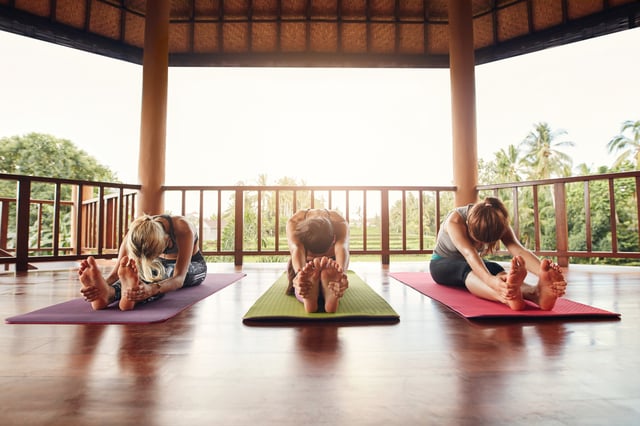I recently found myself standing in the produce section of Whole Foods, somewhere between the lettuce and onion island, and I had no idea how I’d gotten to where I was.
This is not an abduction story, a memory-lapse or early-onset Alzheimer's. What I experienced is an unfortunately commonplace phenomenon that is—in many people’s opinion—becoming a societal disease: a lapse in mindfulness.
Estimated reading time: 4 minutes
 What Is Mindfulness Anyway?!
What Is Mindfulness Anyway?!
Berkeley’s Greater Good Magazine defined mindfulness as: “maintaining a moment-by-moment awareness of our thoughts, feelings, bodily sensations, and surrounding environment.”
Has someone ever asked, “how are you?” and you realize that you don’t actually know?
Have you ever driven from point A to point B and been so caught up in your thoughts that you don’t know if you stopped at every stop sign?
Have you spaced out while supposedly listening to your partner?
Like suddenly coming-to amid the Whole Foods vegetables, all of these are examples of being unaware of either our inner or outer landscape.
As a yoga instructor, I check students in for class and more often than not they are harried, on their phones, and exhausted from doing too many things at once.

The Power of Presence, Just Being
The sweetest moment is the communal sigh of relief as class begins and I remind them that they’ve arrived; there’s nothing else they need to do but be and breathe.
Many times we don’t realize that we are going through the motions of life distracted until we stop. Whether it’s a yoga class, a sudden realization in the grocery store, or a serious repercussion like a car accident—something will open our eyes. As they say, hindsight is 20/20.
In short, being more mindful means trading the glazed-over endless scroll of media overload for a life you're actively living.
It’s not about achieving enlightenment; it is about having a happy relationship, being productive, enjoying your life and effectively coping with stress.
Being mindful and awake in the moment can be difficult.
The good news is that it gets easier with practice. Like showing up to a yoga class or starting a new project, the first step is often the hardest, so it's helpful to look at what gets in the way of making change stick.
Replace the Distraction of Technology with Mindful Use
One of the biggest distractions from mindfulness is technology addiction. Phones, in particular, have revolutionized society and human communication in just the last ten years.

This is not to say that technology is bad, but it is powerful. Screens can easily distract us from our inner feelings and outer environment.
When I “came-to” in the grocery store, my smartphone was in my hand and I realized I’d been looking up something—or maybe doing many somethings at once—but I wasn’t sure what.
Rather than attempting a total tech detox, which is unsustainable and largely unrealistic in our society, try reducing the pull of tech.
Unsubscribe from those e-mail blasts you never read but always spend time deleting.
Turn off unnecessary notifications.
Do you really need a flag whenever someone posts in that Facebook group?
Try putting your phone out of sight when you’re in a situation where being present matters, like talking with your child, navigating home or sending a work e-mail.
The fewer unnecessary red dots that pop up on our iPhones, the more awareness we can give to regaining inner peace, completing the task at hand or listening to the person we are with.
And it's entirely possible that it might not feel like you’re struggling to stay present, aware or engaged.
Mindfulness means being less distracted at work, making more genuine friends (let’s be honest, making friends once you are an adult can be tough), and remembering details your partner mentions that mean a lot to him/her.
How to Be More Mindful
An essential ingredient of breaking any unconscious, habitual patterns is curiosity.
Being curious about your lifestyle will naturally help you become more aware of the times when your brain is jumping at warp-speed between too many things.
Without trying to change or fix your behavior, simply take time to notice.
The first step of being more mindful is becoming aware
of yourself.
Going back to that Berkeley definition, it involves “awareness of our thoughts, feelings, bodily sensations, and surrounding environment.”
 You can practice self-awareness while relaxing in the sun, commuting on the subway, or any everyday task. such as brushing your teeth.
You can practice self-awareness while relaxing in the sun, commuting on the subway, or any everyday task. such as brushing your teeth.
Bring your awareness to your own body and surroundings. Using all your senses, focus on the smells, the warm breeze on your face, or simply your body letting go of tension.
For a moment, don’t let your mind wander or think about the many things you have to do. (They will inevitably be there for you when you return to them.) Once you’ve assessed your state of being, you can return with renewed presence of mind.
Trade Stress for Moments of Being Present
Seizing these small opportunities to center and be completely present throughout our day shifts us from automatic pilot and stress to a restful alertness.
Which brings us to the best way to learn how to be more mindful: practice.
Perhaps pick one time of day to practice (or whenever you're feeling overwhelmed). Or choose one conversation a day where you'll be more mindful.
Commit to minimizing distractions, noticing your own feelings and reactions, being aware of the other person and seeking to understand.
Then once you can stay present once a day, progress to two mindful conversations a day. Then three, four, etcetera. Increase the frequency as you get better at staying present.
How to Develop More Mindful Conversations
Before even giving the other person a chance to finish speaking, we often jump to conclusions or we're preoccupied with what we are going to say next.
For more mindful conversations—whether with your boss, family, partner, grocery store clerk or someone who annoys you—refine your focus.
Make eye contact when appropriate, even if it might feel uncomfortable or vulnerable for you.
Seek to truly listen, understand, and empathize with the other person’s words before assigning meaning to what they’re saying. As you listen and look at the other person in a conversation, notice what sensations or feelings are springing up inside yourself.
Again, this is not about changing or fixing—first you just want to notice.
Once aware of your own anxiety, anger, tight stomach, racing heart, or whatever it might be, you’ll be less prone to act on those feelings without thinking.
Helpful tools like the deep breathing techniques we blogged about here or Jae Ellard wrote a wonderful piece for Mindful Magazine about how we humans are hardwired to react.
“Our brains are biologically wired to make snap judgments and prompt rapid emotional reactions in order to help us manage threats—it’s an ancient form of self-protection that served us well in our cave-dwelling days, but no longer matches the social nuances and (relative) physical safety of the modern world. Our toughest talks are full of half-truths—not because we're serial liars, but because we're survivalists."
With this in mind, try to look at the other person for body language cues and listen to his/her words for understanding. Put simply: practice other-focus in your interactions.
There will inevitably be lapses; you will walk into yoga class scatterbrained, drive home without noticing any stoplights, forget a new acquaintance's name or something your partner has already told you many times.








